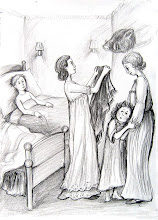Abel, Elizabeth. Virginia Woolf and the Fictions of Psychoanalysis (Women in Culture and Society Series). Reprint Edition. University Of Chicago Press, 1993.
In Virginia Woolf and the Fictions of Psychoanalysis, Elizabeth Abel presents us with a fascinating perspective on the works of Virginia Woolf. Abel shows the connections between Woolf and some of the prevailing theories of psychoanalysis, specifically drawing parallels between Woolf’s work and the work of both Sigmund Freud and of Melanie Klein, a pioneer in the field of child psychology. Abel’s examination of To The Lighthouse reveals the association of the Oedipal theories of Freud in the characterizations of James and Cam, while the characterization of Lily Briscoe reflects the theories of Klein. Both Freud and Klein developed theories about the formation and the resolution of one’s attachment to the parent figure, although Klein focused more specifically on the mother-infant bond, and its impact on the formation of a person’s sense of self. In 1925, the year in which Woolf published Mrs. Dalloway and two years prior to the publication of To The Lighthouse, Klein presented a series of lectures to the British Psycho-Analytic Society. The topic of these lectures was an examination of the power of the mother over her children. Instead of delivering the lectures at a university or in some other public space, Klein delivered her lectures in the home of Adrian and Karin Stephen, Virginia Woolf’s brother and sister-in-law. Abel finds that the influence of Klein’s theories can be seen through Woolf’s construction of Lily Briscoe: “Lily finds in the ‘language’ of painting (both the spatial relations on the canvas and the discourse they represent) a means of representing the boundary negotiations that characterize the mother-infant bond.” (69) Additionally, Abel suggests that the differences between Cam’s relations to her mother, when contrasted to the relations between Lily and Mrs. Ramsay, further highlight Woolf’s attempt to resolve some of her own conflicting feelings about her mother: “The ongoing negotiation of mother-child boundaries also differentiates Lily from Cam. The place of the daughter that was occupied by Elizabeth Dalloway splits in this text between the literal daughter, Woolf's biographical counterpart within the Ramsey family, and the figurative daughter, freed by her distance from both Ramsays to think back through her (surrogate) mother.” (47)
If Abel is correct, Lily’s creative process is influenced by a subconscious need to explore or resolve the mother-infant bond. Therefore, if Lily is indeed a representation of Woolf herself, Abel’s explanation guides the reader to a deeper understanding of Woolf’s narrative. Woolf’s attachment to her own mother is well-documented. Throughout various essays and diary entries, Woolf herself characterizes her preoccupation with her mother as an obsession. The parallels between Woolf’s family and the Ramsays are widely recognized and have been thoroughly discussed. Additionally, many critics suggest that Lily Briscoe is a representation of Woolf herself, a woman artist trying to be true to her art in the face of societal expectations. In her preface, Abel also notes, “Woolf’s engagement with psychoanalysis was deeply embedded in history. Increasingly through the 1920’s – the major decade of her career, and the primary focus of this study – Woolf’s narratives move backward towards a maternal point of origin that Freud, in the same decade, both acknowledged and occluded and that Klein mapped with greater complexity.” (xvi) What makes this source particularly interesting is the way Abel connects Woolf’s fascination with psychology and psychoanalysis both to the motivation for Lily’s art and creative instincts, and also to her relationship to the maternal symbol of Mrs. Ramsay. “In painting, Lily seeks a mode of representation outside the father's symbolic universe. Her use of spatial relations to articulate the earliest human relation looks forward to the development of Klein's perspective within object relations theory from the 1950's through the 1980's. By linking narrative, gender and representation, To the Lighthouse anticipates contemporary psychoanalytic controversies in the encounter it stages between Freud and Klein.” (47) Throughout the book, Lily’s attachment to Mrs. Ramsay is clear. As with Woolf and her mother, Lily is both drawn to Mrs. Ramsay and struggles to separate herself from Mrs. Ramsay’s vision of her, with respect to marrying and settling into a conventional life. As an artist, Lily is driven to create. Her feelings about Mrs. Ramsay at once generate both creative inspiration for her painting and exasperation with the spatial arrangement. Abel suggests that the completion of Lily’s painting at the end of the book also provides psychological resolution: “The painting also serves the different process of Lily’s separation from Mrs. Ramsay; the line that solves the problem of the empty space at the center of the canvas at once restores Mrs. Ramsay and asserts Lily’s autonomy.” (70)
Tuesday, December 8, 2009
The Influence of Psychoanalytic Theory
Subscribe to:
Post Comments (Atom)



No comments:
Post a Comment